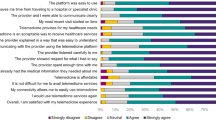Abstract
Background
Many studies have highlighted concerns about the completeness and quality of information found online and how this may affect patients’ education about their medical problems. One aspect of internet usage that has received less attention in the literature, however, is patient perception of the information that is gathered online, and how patients use it related to their musculoskeletal care.
Questions/Purposes
The objective of the study is to utilize a cross-sectional study design to describe internet usage and patient perceptions of orthopedic online information and to identify differences in usage patterns.
Methods
One thousand two hundred ninety-six questionnaires were distributed to consecutive patients at orthopedic outpatient clinics which consisted of questions pertaining to patients’ internet use. Basic demographic data were collected, and subgroup analyses were performed to examine the effect of three variables (age, gender, and clinic type) on various outcomes.
Results
84.9% of patients reported access to the internet. Of patients with internet access, 64.7% reported using the internet for obtaining orthopedic information. 43.1% of the respondents who searched for orthopedic information rated it as “very useful,” 56.3% found it “somewhat useful,” and 0.6% found it “not at all useful”. Younger patients were more likely to have used the internet for health and orthopedic information and to have found this information either very or somewhat useful. Males were more likely to have found the internet information very useful. Overall, only 33.7% of patients who researched their current orthopedic complaint accessed the institutional website for information.
Conclusion
A large proportion of patients use the internet to research orthopedic information and most patients, especially younger males, find the information useful.


Similar content being viewed by others
References
Aslam N, Bowyer D, Wainwright A, Theologis T, Benson M (2005) Evaluation of Internet use by paediatric orthopaedic outpatients and the quality of information available. J Pediatr Orthop B. 14(2):129–33.
Beall MS 3rd, Golladay GJ, Greenfield Ml, Hensinger RN, Biermann JS (2002) Use of the Internet by pediatric orthopaedic outpatients. J Pediatr Orthop 22(2):261-4.
Beredjiklian PK, Bozentka DJ, Steinberg DR, Bernstein J (2000) Evaluating the source and content of orthopaedic information on the Internet. The case of carpal tunnel syndrome. J Bone Joint Surg Am 82-A(11):1540–3.
Bruce-Brand RA, Baker JF, Byrne DP, Hogan NA, Mccarthy T (2013) Assessment of the quality and content of information on anterior cruciate ligament reconstruction on the internet. Arthroscopy. 29(6):1095–1100. doi: 10.1016/J.Arthro.2013.02.007.
Duncan IC, Kane PW, Lawson KA, Cohen SB, Ciccotti MG, Dodson CC (2013) Evaluation of information available on the internet regarding anterior cruciate ligament reconstruction. Arthroscopy. 29(6):1101–1107 doi: 10.1016/J.Arthro.2013.02.008.
Fraval A, Ming Chong Y, Holcdorf D, Plunkett V, Tran P (2012) Internet use by orthopaedic outpatients - current trends and practices. Australas Med J. 5(12):633–638 doi: 10.4066/Amj.2012.1530.
Gupte CM, Hassan AN, Mcdermott ID, Thomas RD (2002) The internet--friend or foe? A questionnaire study of orthopaedic out-patients. Ann R Coll Surg Engl. 84(3):187–92.
Jariwala AC, Kandasamy, ARJ, Wigderowitz CA (2004) Patients and the internet: a demographic study of a cohort of orthopaedic out-patients. Surgeon. 2(2):103–6.
Mathur S, Shanti N, Brkaric M, Sood V, Kubeck J, Paulino C, Merola AA (2005) Surfing for scoliosis: the quality of information available on the Internet. Spine (Phila Pa 1976). 30(23):2695–700.
Romano R, Baum N (2014) Reputation management. J Med Pract Manage. 29(6):369–372.
Sambandam SN, Ramasamy V, Priyanka P, Ilango B (2007) Quality analysis of patient information about knee arthroscopy on the World Wide Web. Arthroscopy. 23(5):509–513.e2. doi: 10.1016/j.arthro.2006.12.007.
Segal J (2012) Managing your online reputation. J Med Pract Manage. 27(6):341–3.
Shuyler KS, Knight KM (2003) What are patients seeking when they turn to the Internet? Qualitative content analysis of questions asked by visitors to an orthopaedics Web site. J Med Internet Res. 5(4):e24 doi: 10.2196/Jmir.5.4.E24.
Source: Internet World Stats (2015) Internet Usage Statistics: The Internet Big Picture. In: Internetworldstats.Com. Accessed September 1 2015.
Starman JS, Gettys FK, Capo JA, Fleischli JE, Norton HJ, Karunakar MA (2010) Quality and content of Internet-based information for ten common orthopaedic sports medicine diagnoses. J Bone Joint Surg Am. 92(7):1612–1618 doi: 10.2106/Jbjs.I.00821.
Verhoef LM, Van De Belt TH, Engelen LJ, Schoonhoven L, Kool RB (2014) Social media and rating sites as tools to understanding quality of care: a scoping review. J Med Internet Res. 16(2):e56 doi: 10.2196/Jmir.3024.
Yi PH, Ganta A, Hussein KI, Frank RM, Jawa A (2013) Readability of arthroscopy-related patient education materials from the American Academy Of Orthopaedic Surgeons And Arthroscopy Association Of North America Web sites. Arthroscopy. 29(6):1108–1112 doi: 10.1016/J.Arthro.2013.03.003.
Author information
Authors and Affiliations
Corresponding author
Ethics declarations
Conflict of Interest
M. Tyrrell Burrus, MD; Brian C. Werner, MD; James S. Starman, MD; Gregory M. Kurkis, MD; Jonathan M. Pierre, BS have declared that they have no conflict of interest. Joseph M. Hart, PhD reports other from Elsevier and Springbok, Inc., and grants from Genzyme, outside the work. David R. Diduch, MD reports grants from Aesculap/B. Braun, Genzyme and Zimmer, personal fees from Depuy-Mitek, other from Smith and Nephew and Springer, outside the work.
Human/Animal Rights
All procedures followed were in accordance with the ethical standards of the responsible committee on human experimentation (institutional and national) and with the Helsinki Declaration of 1975, as revised in 2008 (5).
Informed Consent
Informed consent was obtained from all patients for being included in the study.
Required Author Forms:
Disclosure forms provided by the authors are available with the online version of this article.
Electronic supplementary material
ESM 1
(PDF 1224 kb)
Rights and permissions
About this article
Cite this article
Tyrrell Burrus, M., Werner, B.C., Starman, J.S. et al. Patient Perceptions and Current Trends in Internet Use by Orthopedic Outpatients. HSS Jrnl 13, 271–275 (2017). https://doi.org/10.1007/s11420-017-9568-2
Received:
Accepted:
Published:
Issue Date:
DOI: https://doi.org/10.1007/s11420-017-9568-2




